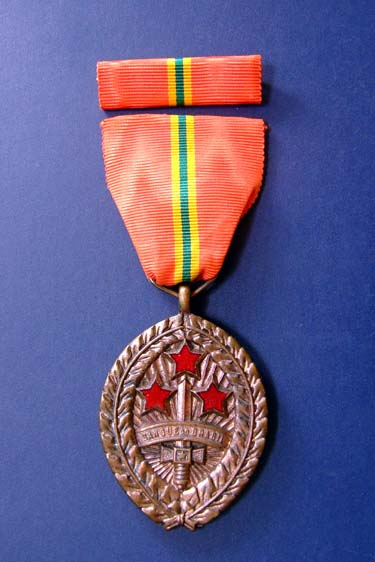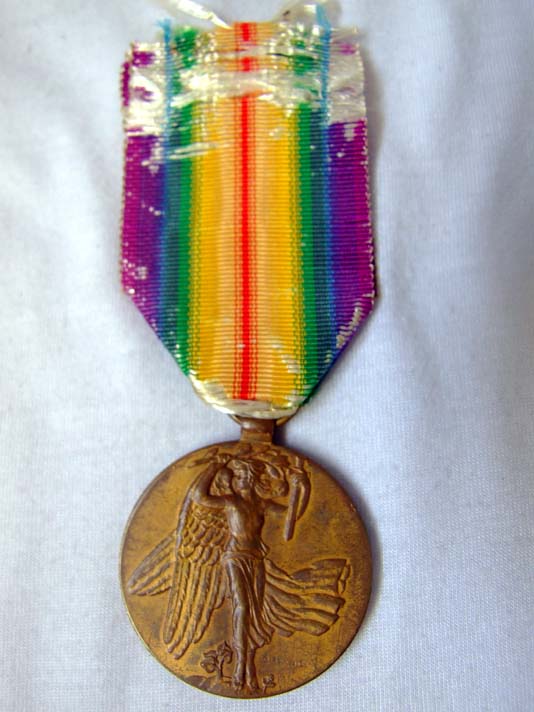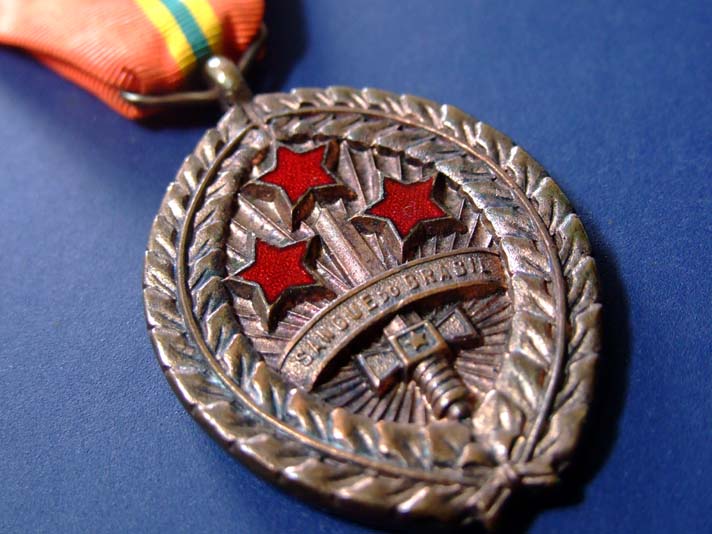-
Posts
1,219 -
Joined
-
Last visited
Content Type
Profiles
Forums
Blogs
Gallery
Events
Store
Posts posted by lambert
-
-
-
Created by Decree-Law 6795 17 August 1944, the cross of Combat soldiers who was intended to distinguish them in action, being:
a) first class-for all who practice acts of bravery or reveal a spirit of sacrifice in performance of combat missions. This can be conferred the medal units which protrude into the fight.
b) 2nd class-participants made exceptional charged jointly by several military.
In reverse aligned subtitles: UNITED STATES of BRAZIL; just below: relief, being the first abridged: follow-up will be written the name of fighting remembered and the date on which it was practiced the Act of bravery.Silk Ribbon red with green surrounds on the sides.
Combat cross 2nd Class-at all similar to first-class, but silver and taking in reverse: "2nd Class" instead of "1st class".
0 -
Do you have any of those in your collection? I would love to see these medals.
Hello Paul
Yes I have almost all ..
I just do not have the Combat Cross 1st Class. medals and one of the rarest Brazilian War between the Brazilian collectors it costs on average $ 1,500.
I'll post in the forum this week.
but as a preview, they are on my website
0 -
I have no official confirmation but were issued about 2,720 "blood of Brazil" for the wounded in the fighting. and 465 for those killed in action.
Lambert
0 -
That is a very attractive medal. Is it still in use today for those who are wounded in battle? What other WW2 medals are there for Brazil?
Hello Paul!
Blood Medal of Brazil it is no longer delivered since 1945.
There is 4 more medals for the Brazilian Expeditionary Force in World War II.
Campaign Medal
War Medal
Combat Cross 1st class
Combat Cross 2nd class
Lambert
0 -

Sagt. Max Wolff ( KIA: 12 apr. 45)
0 -
-
-
This oval bronze medal was instituted on 5 July 1945 for Brazilian troops and civilians who served in war operations and who were injured through actions
against the enemy. The three stars on the obverse are symbolic of the three wounds received by Brigadier Sampaio at the battle of Tuiuti in 1866, against Paraguay.
Across the obverse is a scroll inscribed "Sangue Do Brasil" (Blood of Brazil). The reverse shows the globe as it is also displayed on the Brazilian national flag.

 0
0 -
very nice these miniatures.
This here is my first mini French War.


The medal next to the Croix de Guerre, I do not know ... Anyone know?
Lambert
0 -
1930-1931 (This type)
Lorenzo
Thanks my friend

lambert
0 -
JB Floyd
Thank you very much, this is one of the rare medals in Iraqs military kingdom era. I am glad that I was able to find a complete one with the original ribbon. I have seen a few of these and most of them the ribbon was replaced.
Lorenzo
When is this medal? what time?
Lambert
0 -
Here in Brazil, and a terrible mistake to attempt to clean the medal and also the Ribbon. Totally reprehensible.

is how to remove a little of the history of the medal. I remember that she may have been used often by the war fighter with great pride.
Lambert
0 -
It is possible that patches of chlorine? used for cleaning.
Lambert
0 -
-
Sorry for getting into this thread late, but I had pressing needs
Rob,
If you look a little closer you will see there is a large piece of a spacer bar at the bottom of the Meuse-Argonne clasp, which means at some time the spacers were removed? And it was not to be the bottom clasp.
Regards, Jim
Hello everyone.
I already knew this defect, it's just a wrong soldering. the last clap no spacers.
 0
0 -
Hello Lambert,
It is not entirely unusual to see a us vic with the DEFENSIVE SECTOR (DS) clasp on the top. There are numerous other examples seen with the Defensive Sector clasp out of order. It has been suggested that these clasps were placed on the top in the time when it was still not confirmed exactly where the DS clasp would sit. The original battle clasps were approved earlier than the DS clasp. It is interesting that in your example the bottom MEUSE-ARGONNE claps has no spacers. This would probably indicate that, at the time of issue, it was supposed to be the bottom clasp.
It wasn't until after the DS clasp was authorised that the dress regulations were changed to indicate the DS clasp was to be placed on the bottom. Now it is much more common to see the us vics with the DS clasp on the bottom with the spacers removed.
I have such a us vic in my collection that has the DS clasp on top which was issued in early 1920 and another couple where the DS clasp still has its feet. It is also not unusual to see us vis without a DS clasp if the recipient did not receive the medal originally with the clasp.
A nice example of an early issue vic.
Regards,
Rob
Thanks Rob!
Your response is entirely plausible.
I had this doubt for a long time .. would think it was a fake, then placed to appreciate the Medal.
Lambert
0 -
Hello Lambert,
The designers mark in the case should be 'O. Spaniel' for Otakar Španiel, 1881-1955.
Regards,
Rob
Rob..
correct !!
I do not know how he came to my mind.

lambert
0 -
This is another of my collection
Victory Medal Czech.
Medal Type 2. Signature of the sculptor O. Cavalier on the obverse.
Manufacture of Kremnica Mincovňa.



Lambert
0 -
Thanks guys!
Jeff,
I don't see any stamps in the upper cross arm on this example, so do you think this one might have actually been unissued?
Tim
1st type : model made by the Casa da Moeda Rio de Janeiro (the equivalent of the Monnaie de Paris in France). It is a bronze cross and hit very flat in one piece. The center of the obverse shows the Southern Cross found on the Brazilian national flag. On the edge of the bottom branch is the inscription Casa da Moeda , and on the edge of the left branch, registration Rio . This first type is the official model.
So I was wrong.
This medal is a type 2. (unmarked)

Lambert
0 -


Commemorative Cross 1917-1918, Type 1 Tape fighter, obverse and reverse.


Commemorative Cross 1917-1918, Type 2 tape fighter, obverse and reverse.


Commemorative Cross 1917-1918, type 3, non-combatant ribbon, obverse and reverse. On the obverse, on the upper branch of the cross is the Roman numeral II (Private etching according to the authors cited above) that refers to the two halves of war to which the recipient would have participated ...


Commemorative Cross 1917-1918, Type 4 tape fighter, obverse and reverse.
I got 99% that this is the Type 1

Lambert
.
0 -
I thought this might be interesting to many of you. It's a scanned book from 1915 entitled "War Medals and Their History"
http://picasaweb.goo...ndTheirHistory#
Thanks to Sarge Booker for scanning it and sharing the link.
Cheers
Chris
Thanks Chris.
very good.
lambert
0 -
Now, if they only had Silver Stars!!

Hi Tim
I also.
 0
0 -
It was founded in August 1922 to honor all those who participated, apart from the Brazilian territory, operations related to the First World War between 26 October 1917 and November 11, 1918. It is therefore not, as is often read, a Croix de Guerre but a commemorative medal shaped cross. To distinguish between combatants and noncombatants (medical personnel, crews of the merchant marine, administrative staff), the order of creation includes two ribbons:
- Veterans : orange with three black stripes 3mm wide, one center and two sides. It covers all military personnel, the vast majority of recipients who served in the Navy. According to Nat Futterman and Jeffrey Floyd - "Brazil's Cross Campaign 1917-1918" , The Medal Collector (OMSA), March 1996 - the number of beneficiaries would be around 960.
- noncombatants : the same except that the stripes are white instead of black. According to the same sources, the number of claimants for this alternative band would be around 360.
There are several manufactures who can sketch a typology.
1st type : model made by the Casa da Moeda Rio de Janeiro (the equivalent of the Monnaie de Paris in France). It is a bronze cross and hit very flat in one piece. The center of the obverse shows the Southern Cross found on the Brazilian national flag. On the edge of the bottom branch is the inscription Casa da Moeda , and on the edge of the left branch, registration Rio . This first type is the official model.
2nd type : it is identical to the previous model but it would be a privately held manufacturing may be used across the Rio de la Monnaie. The big difference is the lack of markings on the branches.
3rd kind : model also manufacture private, probably Brazil, but with significant differences compared with the two previous types.
4th type : French made (it is found on the catalog Delande 1934), it is sometimes considered a "copy" for collectors. Her appearance betrays its origins as it is developed as the French Croix de Guerre: fairly thick, the centers reported and a grainy background. In addition, he is the only one to carry on the obverse, in the upper branch of the cross, the Roman numeral VIII to recall the 8 semesters long war. Cest probably the model more "common".
The original text in French. was translated into English.
Lambert
0






cross of Combat 1ª e 2ª Classe
in Rest of the World: Militaria & History
Posted